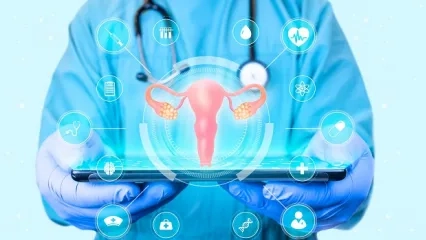Alo Yeditepe
Alo Yeditepe
Chronic Pelvic Pain
Chronic pelvic pain is defined as the feeling of pain or discomfort felt in the area from the underside of the belly button to the upper part of the thigh called the pelvic region. Pelvic pain, which is as common as back pain and asthma, can also be seen with pain during intercourse, which people are afraid to talk about and which affects their quality of life.
There are more than one cause of chronic pelvic pain. Although pain is a problem in itself in some cases, it can also be a symptom of a different problem in some cases. Therefore, in chronic pelvic pain due to a different disease or problem, treating this problem may be sufficient for the treatment of pain. However, it is usually not possible to attribute chronic pelvic pain to a single cause. In such cases, it is aimed at improving the patient's quality of life by reducing both the pain and other symptoms experienced by the patient.
Chronic Pelvic Pain Symptoms
Chronic pelvic pain is in the form of blunt, sharp, or constant pain in the form of a cramp. Pressure or weight may be felt in the pelvic area at the same time. This feeling may be temporary or permanent. The severity of pelvic pain may vary; it may be mild, not disruptive to daily life, or it may be severe enough to restrict daily activities. Patients usually describe chronic pain as follows.
- Constant and severe pain
- Periodic incoming and outgoing pain
- Dull pain
- Sharp pains in the form of cramps
- The feeling of weight and pressure in the pelvis
However, some patients may complain of pain during intercourse, while urinating, or sitting for a long time.
Factors Leading to Chronic Pelvic Pain
Pelvic pain is considered chronic if it persists for 6 months or longer. The factors causing chronic pelvic pain are listed as follows:
Endometriosis
It is a condition in which tissue similar to the endometrial tissue that normally covers the inside of the uterus begins to grow in places other than the uterus, such as the ovary, Fallopian tubes, and abdominal lining. Endometriosis can affect women of all ages. This tissue responds by accumulating and breaking down just like the endometrium in response to hormonal changes in each menstrual cycle, causing minor bleeding inside the pelvis.
It causes inflammation, swelling, and scarring of the normal tissue surrounding endometriosis tissues. As a result, fibrous tissue bands may form that may cause the tissues and organs in the pelvis to stick together. Endometriosis can cause pain, especially during menstruation.
Tension in Pelvic Floor Muscles
Adhesions in the PelvisAdhesions can be caused by an old infection, endometriosis, previous surgery, or other problems in the area. Pelvic adhesions may cause chronic pelvic pain in some women and may also lead to other symptoms, depending on where they are seen.
Ovarian Cysts
Ovarian cysts occur when the ovaries are unable to release eggs. When this happens, a growth called a cyst occurs in the area, which may produce swelling, pressure, or pelvic pain on the side of the body where the cyst is located.
Pelvic Congestion Syndrome (PCS) (Congestion in Vessels on the Pelvic Floor)
PCS, which is quite common and potentially causes serious restrictions in daily activities in women, is one of the causes of chronic pelvic pain. Approximately one-third of all women experience chronic pelvic pain at some point in their lives. PCS is associated with what is known as ovarian and pelvic vein enlargement.
This can cause varicose veins in the pelvis, thighs, hip areas, or vaginal area. By definition, chronic pain lasts longer than six months and is not related to a woman's menstrual cycle. PCS should be considered if the pain worsens while sitting or standing and is relieved by lying down. Some patients may also experience pain while urinating (dysuria) or during/after sexual activity (dyspareunia). PCS, a complex medical condition, requires a multidisciplinary team approach for treatment and evaluation.
Irritable Bowel Syndrome
Irritable bowel syndrome (IBS) is a disease that affects your gastrointestinal tract. This includes the small intestine and the large intestine (colon). It is diagnosed when a person has abdominal pain or spasm associated with a change in the appearance or frequency of bowel movements. It causes changes such as belly cramps, gas, bloating, diarrhea, or constipation. IBS is a long-term, chronic condition and can be painful.
Bladder Pain Syndrome (Interstitial Cystitis)
Bladder pain syndrome is a condition that is not sufficiently understood that you have pelvic pain and voiding problems. It is sometimes called interstitial cystitis (IC) or painful bladder syndrome (bps). The main symptoms of bps (interstitial cystitis) include intense pelvic pain (felt on your lower abdomen), a sudden strong urge to urinate, more frequent urination than usual, pain in the lower abdomen that relieves after urinating and increases when your bladder is full, waking up several times during the night to need a toilet, difficulty urinating urinary incontinence, and blood in the urine (hematuria). Although BPS (interstitial cystitis) can affect people of all ages, it is much more common in women than men, usually above 30 years of age.
Psychological Factors
(History of Depression, Chronic Stress, Sexual or Physical Abuse)
Diagnosis of Chronic Pelvic Pain
Examination and imaging methods are used for the correct diagnosis in people who apply with pain complaints.
Gynecological/Pelvic Examination
The gynecological/pelvic examination performed with the patient's history helps to detect areas of infection, abnormal growth of the pelvic floor muscles, tension, or sensitivity.
Laboratory Tests
Blood tests, culture tests, urine tests, and different laboratory tests may be requested for symptoms. For example, vaginal culture tests may be required to screen for infections such as chlamydia or gonorrhea in the gynecological examination or urinalysis may be required to determine urinary tract infection.
Ultrasound
Ultrasound is performed to evaluate the ovaries, uterus, and tubes structurally.
Other Imaging Tests
If any abnormality is detected during gynecological examination and ultrasound evaluation, advanced examination, and imaging methods such as computed tomography (CT) or magnetic resonance imaging (MRI) can be used.
Chronic Pelvic Pain Treatment
The purpose of chronic pelvic pain treatment is to reduce symptoms and improve quality of life. Although a personalized treatment approach is adopted, the optimal approach to pain usually includes a combination of treatments. In this direction, the treatments listed below are planned and applied individually or together according to the needs of the patient.
Painkillers
Analgesics such as acetaminophen and nonsteroidal anti-inflammatory drugs are generally well tolerated, but studies have concluded that nonsteroidal anti-inflammatory drugs are not effective in treating chronic pelvic pain associated with endometriosis.
Hormonal Treatment
Oral contraceptives are effective in treating dysmenorrhea associated with endometriosis, although there is only limited evidence that they are beneficial for non-menstrual pelvic pain. The intrauterine system (Mirena) releasing levonorgestrel has been shown to reduce the recurrence of dysmenorrhea if placed after laparoscopic treatment of endometriosis.
Antidepressants
Oral contraceptives are effective in treating dysmenorrhea associated with endometriosis, although there is only limited evidence that they are beneficial for non-menstrual pelvic pain. The intrauterine system (Mirena) releasing levonorgestrel has been shown to reduce the recurrence of dysmenorrhea if placed after laparoscopic treatment of endometriosis.
Surgical Treatments
Physical Treatment (Stretching Exercises, Massage, and Relaxation Techniques)
Diet and Nutrition Treatment
Neuromodulation
Neuromodulation devices stimulate the nerves with electrical signals or other forms of energy. For selected patients, through a multidisciplinary assessment, in addition to other care, or when symptoms do not adequately respond to more conservative measures, e.g., when existing drugs are ineffective or become problematic for long-term use), tolerance, dependence, adverse side effects or development of toxicity) neuromodulation treatment may be considered.
Trigger Point Injections
It aims to reduce the tension of the connective tissue and restore the mobility of the muscle fascia. Patients who were treated for at least one month had a 25% or greater improvement.
Psychotherapy
Acupuncture
Patients who cannot benefit from other treatments, especially medication, for chronic pelvic pain are trying alternative methods to solve their problems. Acupuncture is also one of these methods. Acupuncture, which has been used in the treatment of many diseases in the far east for thousands of years and the west for the last 60 years, is also used in the treatment of chronic pelvic pain.
Cognitive Behavior Therapy
Regardless of the underlying cause, it is a critical component of care for women with chronic pelvic pain. One promising treatment modality is a mixture of cognitive psychotherapy and physiotherapy, called somatocognitive therapy. Its purpose is to promote awareness of one's own body, develop coping strategies, and release muscle pain manually.
This content was prepared by Yeditepe University Hospitals Medical Editorial Board.
”
See Also
- What is Autism Spectrum Disorder?
- What is Hypoglycemia?
- Contraceptive Methods: Birth Control and Effective Protection Options
- Uterine Polyps, Symptoms and Treatment
- Genetic Diagnosis in IVF Treatment
- What Happens at 3rd Weeks of Pregnancy?
- What Happens at 2nd Week of Pregnancy?
- What is Endometriosis? What are the Symptoms of Endometriosis?
- What is Mythomania (Pathological Lying Disorder)? What Causes Mythomania?
- What are the symptoms of a Panic Attack? How to Overcome a Panic Attack?
- What Does Narcissist Mean? Narcissistic Personality Disorder
- ThuFLEP Treatment Improves Quality of Life in Benign Prostatic Hyperplasia
- Treatment of Urinary System Stones with Thulium Fiber Laser
- ThuFLEP Method in Benign Prostate Enlargement
- What is Pelvic Floor? What are Their Duties?
- The Most Common Diseases in Women
- What is Hysteroscopy? Hysteroscopy Usage Areas
- What is Myoma? Myoma Symptoms and Treatment
- What is Prostate Cancer? Symptoms and Treatment
- Early Menopause and Ovarian Failure Can Be Prevented
- What is Anxiety? What are the Symptoms of Anxiety?
- What is Benign Prostatic Hyperplasia, How is it Treated?
- What is Laparoscopic Surgery in Gynecology?
- Menopause Symptoms and Menopause Treatment
- Polycystic Ovary Syndrome and its Treatment
- Electromagnetic Stimulation in the Treatment of Endometriosis and Infertility
- The Father-Child Relationship Reflects on Personality Traits
- Early Diagnosis Saves Lives in Insidiously Progressing Kidney Tumors
- How Does Working Life Affect Prospective Mothers?
- Did You Know That Our Bodies are Managed by Hormones?
- Causes of Female Infertility
- The Use of Non-Inpatient Closed Surgery is Increasing in Gynecological Diseases
- Misconceptions About Hypertension
- The Rate Of Kidney Stones Has Begun To Increase In Women
- What is Hypertension?
- HoLEP Eliminates 85 percent of Drug Use in the Treatment of Benign Prostate Enlargement
- How Can We Manage Stress?
- What is Polycystic Ovary Syndrome/PCOS?
- Postpartum Period
- 7 Effective Tips Against Urinary Incontinence
- The Hidden Problem Seen in One out of Every 10 Women: HIRSUTISM
- The Chance of Becoming a Father Increases with Microchip Technology
- Persistent Headache May Be a Sign of Tumor
- The Purpose of Pituitary Diseases is to Avoid Waste of Time with the Right Treatment
- Thanks to the Ovarian Rejuvenation Method, She Counts the Days for Birth!
- Pelvic Floor Muscles Should Be Addressed with a Multidisciplinary Approach
- Protect Children From Sports That Will Knock Their Head
- Some Patients Go Through Menopause Even at the Age of 15
- Useful Bacteria Increases IVF Success
- Polycystic Ovary Syndrome Can Occur If the Bacteria in the Gut Are Not Functioning Well
- Doctor Support for the Ban on Heading by Children
- Imaging Methods During Pregnancy
- After 16 Years, She Wanted to Be a Mother Again; She Experienced the Shock of Her Life
- These Diseases Affect Women Differently Than Men
- Beware of Chocolate Cyst! It Affects 1 in 10 Women
- Causes of Male Factor Infertility
- The Effect of Advanced Age on IVF Treatment
- Head Trauma Can Cause Permanent Damage
- Infertility
- Polycystic Ovary Syndrome
- Early Menopause
- Blocked Fallopian Tube
- Vaginismus
- Low Ovarian Reserve (AMH)
- Which Methods Increase Success in Treatment of Infertility?
- Intrauterine insemination (IUI)
- Microinjection
- Egg Cryopreservation
- Assisted Hatching
- Micro-chip
- Pre-implantation Genetic Diagnosis
- Thyroid Diseases During Pregnancy Affect the Baby as Much as the Mother
- 10 Overlooked Signs of Menopause
- Endometriosis
- Does Prostate Enlargement Develop into Cancer?
- One in Every Four Men Diagnosed with Cancer Has Prostate Cancer
- Ways to Protect Prostate Health
- Surgical Treatment of Prostate Diseases
- Ways to Get Rid of Kidney Stones
- Prostate Preventive Cancer Treatment: Focal HIFU
- HIFU Focal Treatment for Prostate Cancer
- The Things You Should Know About Prostate Cancer
- HoLEP Method in Closed Prostate Surgery
- Benign Prostate Enlargement
- Co-Culture
- Ovarian Rejuvenation / PRP
- As Average Life Expectancy Increases, This Problem Will Be Seen More
- Beware, These Risks Increase After Menopause!
- This Problem Ruins the Lives of One in Every 10 Women
- Getting Cancer Treatment Does Not Stop You from Having Children!
- Prof. Dr. Attar: Endometriosis Can Be Associated With Some Chronic Diseases
- 9 Different Types of Depression
- Father's Role in Child Development is Fatal
- What Is the Period of Fertility? What Tests are Performed for Fertility?
- What is Agoraphobia?
- What Happens at 38 Weeks of Pregnancy?
- What Happens at 37 Weeks of Pregnancy?
- What Happens at 36 Weeks of Pregnancy?
- What Happens at 35 Weeks of Pregnancy?
- What Happens at 34 Weeks of Pregnancy?
- What Happens at 33 Weeks of Pregnancy?
- What Happens at 32 Weeks of Pregnancy?
- What Happens at 31 Weeks of Pregnancy?
- What Happens at 30 Weeks of Pregnancy?
- What Happens at 29 Weeks of Pregnancy?
- What Happens at 28 Weeks of Pregnancy?
- What Happens at 27 Weeks of Pregnancy?
- What Happens at 26 Weeks of Pregnancy?
- What Happens at 25 Weeks of Pregnancy?
- What Happens at 24 Weeks of Pregnancy?
- What Happens at 23 Weeks of Pregnancy?
- What Happens at 22 Weeks of Pregnancy?
- What Happens at 21 Weeks of Pregnancy?
- What Happens at 20 Weeks of Pregnancy?
- What Happens at 19 Weeks of Pregnancy?
- What Happens at 18 Weeks of Pregnancy?
- What Happens at 17 Weeks of Pregnancy?
- What Happens at 16 Weeks of Pregnancy?
- What Happens at 15 Weeks of Pregnancy?
- What Happens at 14 Weeks of Pregnancy?
- What Happens at 13 Weeks of Pregnancy?
- What Happens at 12 Weeks of Pregnancy?
- What Happens at 11 Weeks of Pregnancy?
- What Happens at 10 Weeks of Pregnancy?
- What Happens at 9 Weeks of Pregnancy?
- What Happens at 8 Weeks of Pregnancy?
- What Happens at 7 Weeks of Pregnancy?
- What Happens at 6 Weeks of Pregnancy?
- What Happens at 5 Weeks of Pregnancy?
- What Happens at 4 Weeks of Pregnancy?
- What Happens at 1st. Weeks of Pregnancy?
- Considerations for Embryo Transfer
- What Causes Menstrual Irregularity, How Is It Treated?
- Success in IVF after 43 Decreases to Five Percent
- Diabetes Mellitus and its Treatment
- Who Can Undergo HoLEP Procedure?
- Developmental Disorders in Children
- Treatment of Pituitary Adenomas
- Surgical Treatment of Pituitary Diseases
- Pituitary Clinic | FAQs
- Does Pregnant Coronaviruses Affect?
- Most Frequently Asked Questions During Pregnancy
- What are Pituitary Diseases?
- What is the Pituitary Gland, What are its Functions?
- What is Hirsutism?
- Hirsutism Clinic / FAQs
- Treatment Success in Brain Tumors Also Depends on the Family
- Untreated Genital Problems Can Cause Urinary Incontinence
- Gold Standard Treatment for Benign Prostate Enlargement: HoLEP
- 1 in 10 Women Have This Problem; It Can Lead To Infertility
- Effective Results Can Be Achieved with PRP in Women with Low Egg Count
- 6 Misconceptions About Kidney Stones
- Her Kidney Stone, 6 cm in Size, Was Taken With One And a Half Hour Operation
Alo Yeditepe









